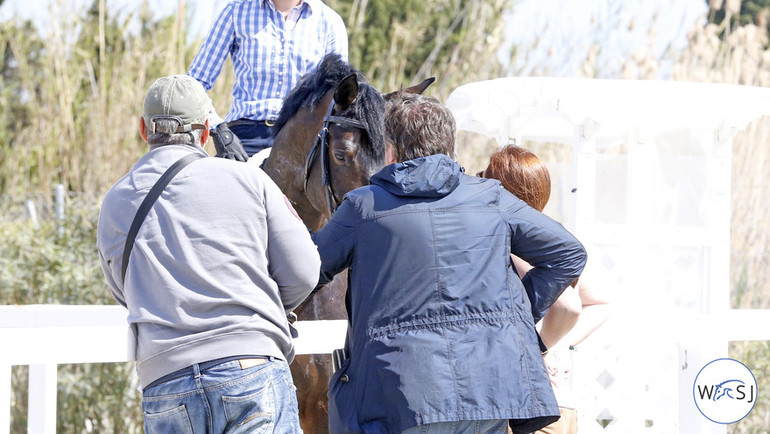In this next addition to the sports psychology series, I’d like to address one of the most important issues faced by riders at any age or level – competitive pressure and anxiety – and offer some practical solutions.
Over the years, I’ve found that riders often lose focus and struggle with performance when they worry about how other riders are doing or how well they will perform in comparison. If riders do well, it can increase pressure to maintain this quality of performance. If they struggle they often fear that it will repeat. It can be very hard to overcome. This problem is huge in all sports, and I’m here to help.
When performance in jumping – or other equestrian disciplines – is tumbling, many think of more and more practice as the only solution. But there really is a mental aspect to all sports and the effect of anxiety and pressure can be devastating. For this reason, practice in the mental realm is often what is most needed and the mere act of taking a fresh mental approach to your sport can help maximize whatever talent you have.
The root cause of many jumping performance problems in the ring is often anxiety, and it has nothing to do with technique – but it sabotages technique at the most important moments. It all boils down to fear. Riders tend to think too much about results, look over their shoulders, fear looking bad or not getting the right outcome for others around them such as owners and/or sponsors or any number of other negative consequences.
The enemy is the old fight-or-flight response which is perfectly appropriate in the wild if you are actually being chased down by a lion. It’s the same response that would occur if a snake was about to attack you, but in the modern era of showjumping, it’s totally inappropriate. Our bodies haven’t caught up with the fact that most sports have only been around for 100 to 150 years. By contrast, we are fighting hundreds of thousands of years of evolution and a process of responding with anxiety to stay alive! In the show ring, this inappropriate response only devastates performance. We react as if we need to run away or fight when we really need to chill.
To break that fight or flight response, it helps to have some serious techniques and strategies in your arsenal like classical conditioning and relaxation, deep breathing, and a different perspective. The real key is not to fight the anxiety response — it’s to make sure it doesn’t get turned on in the first place. In a quiet room the night before a show, after you walked the course or even on the horse a couple of minutes before you enter the ring, you might engage in a particular set of helpful behaviors. Learning and training this with a sports psychologist is best, but you might not have that luxury. For example, you can imagine a calming routine in which you take a deep breath, exhale and then perform in a more automatic mode exactly what you want to do. That is the real key, getting into an automatic way of acting and letting that take over when you jump. The horse will appreciate your calmness, and you will be letting positive habits rule rather than reactions to fear or pressure.
The potential for anxiety to affect a rider is huge. In general, the more times a rider competes or stays actively engaged in competitive activity, the less anxiety will be a factor. But riders are particularly vulnerable because the process of competing may only last 90 seconds, for example, compared to the many hours of build-up and preparation. It’s similar to golf where only about 1 percent of the time on the course actually involves swinging the club. That leaves 99 percent of your time to worry about what your next shot (or in this case jump) is going to look like. That still leaves plenty of time to lose your focus or allow the demons of fear to creep in. Contrast that with a soccer match in which you might be engaged in the sport and continuous activity 85 percent of the total match time. In this regard, showjumping is more like gymnastics, golf, springboard diving and ice skating than soccer, hockey, rugby or basketball.
Riders often have this inner dialogue going that involves a component of fear, dread or pressure. We say about 200 words per minute to ourselves. It certainly does not help if you’re consistently critical of your own performance or worried about what is going to happen with this self-talk. All athletes can think too much, worry, and botch a performance long before it even begins. It’s like a self-fulfilling prophesy. Luckily for those who get help or develop solid strategies, anxiety is one of the problems that resolves best. That is why I love it when a client with anxiety calls me to get help!
Anxiety and worry often comes from the competition itself. Showjumpers are also inherently a very competitive and high achieving group. This breeds pressure. This is especially true in the unpredictable showjumping environment where a horse, and difficult or unpredictable courses comes into play. While some riders feed off this competitive pressure, improving their focus and raising their riding and jumping to a higher level, others allow themselves to be overwhelmed by pressure, choke, and fold.
This pressure and the fight or flight response leads to increased physiological arousal (e.g., butterflies, nervousness, perspiration) and this effect increases as the show or jump class becomes more meaningful to the rider. They are the normal results of sincere effort rather than pathological anxiety states. Evidence that competitive pressure can enhance performance is seen in the fact that most Olympic track records are broken in front of massive crowds, when the pressure is greatest, rather than in practice. But this is far from the case for many who wilt under the spotlight.
Although performance is often improved following normal increases in arousal, the complexity of fine motor skills, the horse, and decision making in pacing, turning and jumping dictates a guard against over-arousal. As such, responding to competitive pressure with additional increases in arousal due to worry, concern, and self-doubt inevitably destroys performance! It also steals attention away from what is important, wasting it on irrelevant fears.
It is unrealistic to try to eliminate all natural competitive pressure. However, the way a rider appraises stressful events determines whether the experienced emotion will be positive or negative. In other words, differences in the way individuals evaluate competitive pressure situations, rather than the situations themselves, explain why some riders thrive while others pack it in.
Competitive pressure appraised as negative will inevitably lead to unhealthy anxiety and less proficient equestrian performance. In contrast, pressure welcomed as a necessary challenge of the thrill of jumping guards against over-arousal caused by needless worries, increases attention to the task at hand and improves overall performance.
What can you do? Here are some guidelines to help you manage competitive pressure in showjumping more effectively:
- Frequently practice as closely as possible to real competitive situations. Training should be as realistic as possible, with lots of competitive opportunities – participating at training shows is an example. As to exercises, you can even make them harder in practice so that when you get to the ring it will be easier.
- Enter as many shows as you can (of course putting the welfare of your horse first) – on as many different horses as you can – to gain necessary experience in a competitive environment. The only way to truly defeat anxiety and pressure is to face it directly rather than avoid it.
- Believe in yourself when the going gets rough. Nervous energy is a natural part of competition. Enjoy your nervousness! It is great fuel for performance. Trust your preparation, stay focused, and hang in there to win the internal battle.
- Have a plan going in and execute that plan as much as possible, but also welcome the uncertainty of competition as one of the most exciting aspects of jumping. It never gets boring when you have a good struggle on your hands!
- Develop some sort of relaxation or meditation routine on your own or with a professional, long before you compete. The best athletes in the world, and all my clients, learn to relax deeply and then imagine their performances many times before they actually go into the ring on the course or on the field. They are so well tuned that the show becomes a thrilling calm pleasure rather than a burden or opportunity to blow it.
Past trauma can possibly affect current anxiety states and increase pressure. If you really want to overcome those issues – or if you just want to train like a pro and have not past demons - seek the services of an experienced sports psychologist.
In summary, managing pressure and anxiety is just another part of becoming a better athlete, and showjumpers are no exception. Rather than be afraid of fear itself, accept and eagerly embrace an approach that puts you in touch with those feelings and the remedy too. By learning to crush the demons of anxiety and pressure with solid mental tools, you’ll find the winner’s circle more often. You might even need a larger display case for all your awards!
Dr. John F. Murray, a licensed clinical psychologist and sport psychologist in Palm Beach, Florida for the past 17 years, was recently called “best in the business” by Psychology Today, USA Today and Metro New York. He is a well-known author and leader in his field with a Ph.D. in Clinical Psychology and Masters degrees both in Clinical Psychology and Sports Psychology/Exercise & Sport Sciences from the University of Florida. He maintains a web site at http://www.johnfmurray.com and provides phone or skype evaluations and mental coaching to athletes worldwide, including show jumpers. He may be reached for questions at: 561-596-9898 or by email at: [email protected]










